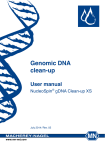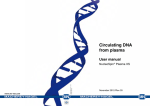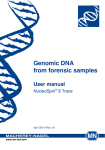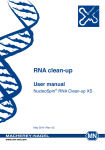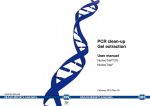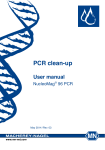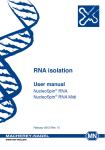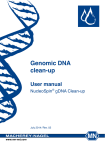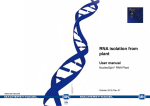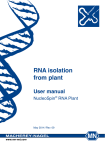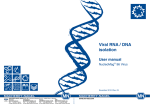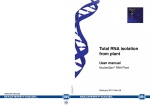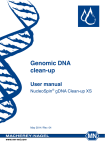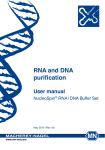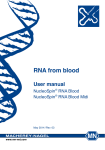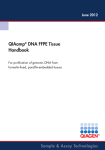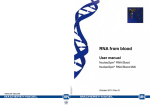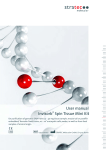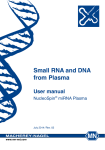Download RNA clean-up
Transcript
RNA clean-up User manual A030383 R03en1/0/3/03.12 PD Printed in Germany NucleoSpin® RNA Clean-up www.mn-net.com MACHEREY-NAGEL March 2012 / Rev. 03 MACHEREY-NAGEL MACHEREY-NAGEL MN EN ISO 9001: 2008 CERTIFIED RNA clean-up Table of contents 1 Components 4 1.1 Kit contents 4 1.2 Reagents, consumables, and equipment to be supplied by user 5 1.3 About this user manual 5 2 Product description 6 2.1 The basic principle 6 2.2 Kit specifications 6 2.3 Handling, preparation, and storage of starting materials 7 2.4 Elution procedures 8 3 Storage conditions and preparation of working solutions 4 Safety instructions – risk and safety phrases 9 10 4.1 Risk and safety phrases 10 4.2 GHS classification 11 5 Protocols 12 5.1 RNA Clean-up 12 5.2 RNA isolation from up to 105 cells 14 6 Appendix 16 6.1 Troubleshooting 16 6.2 Ordering information 18 6.3 Product use restriction / warranty 20 MACHEREY-NAGEL – 03 / 2012, Rev. 03 3 RNA clean-up 1Components 1.1 Kit contents NucleoSpin® RNA Clean-up 10 preps 50 preps 250 preps 740948.10 740948.50 740948.250 Lysis Buffer RA1 10 mL 25 mL 125 mL Wash Buffer RA2 15 mL 15 mL 80 mL Wash Buffer RA3 (Concentrate)* 5 mL 12.5 mL 3 x 25 mL RNase-free H2O REF 5 mL 15 mL 65 mL ® NucleoSpin RNA Binding Columns (light blue rings – plus Collection Tubes) 10 50 250 Collection Tubes (2 mL) 10 50 250 Collection Tubes (1.5 mL) 10 50 250 User manual 1 1 1 * For preparation of working solutions and storage conditions see section 3. 4 MACHEREY-NAGEL – 03 / 2012, Rev. 03 RNA clean-up 1.2 Reagents, consumables, and equipment to be supplied by user Reagents • 96–100 % ethanol (to prepare Wash Buffer RA3 and to adjust RNA binding conditions) Consumables • 1.5 mL microcentrifuge tubes • Sterile RNase-free tips Equipment • Manual pipettors • Personal protection equipment (e.g., lab coat, gloves, goggles) • Centrifuge for microcentrifuge tubes 1.3 About this user manual It is strongly recommended reading the detailed protocol sections of this user manual if the NucleoSpin® RNA Clean-up kit is used for the first time. Experienced users, however, may refer to the Protocol-at-a-glance instead. The Protocol-at-a-glance is designed to be used only as a supplemental tool for quick referencing while performing the purification procedure. All technical literature is available on the internet at www.mn-net.com. Please contact Technical Service regarding information about changes of the current user manual compared to previous revisions. MACHEREY-NAGEL – 03 / 2012, Rev. 03 5 RNA clean-up 2 Product description 2.1 The basic principle One of the most important aspects in the isolation and handling of RNA is to prevent degradation of the RNA during the isolation procedure. With the NucleoSpin® RNA Clean-up kit, RNA containing samples are mixed with a solution containing large amounts of chaotropic ions. This solution immediately inactivates RNases – which are present in virtually all biological materials – and creates appropriate binding conditions which favor adsorption of RNA to the silica membrane. Simple washing steps remove salts, metabolites, organics like phenol, and macromolecular cellular components. Pure RNA is finally eluted under low ionic strength conditions with RNase-free water (supplied). The RNA clean-up preparation using NucleoSpin® RNA Clean-up kits can be performed at room temperature. The eluate, however, should be treated with care because RNA is very sensitive to trace contaminations of RNases, often found on general lab ware, fingerprints and dust. To ensure RNA stability keep RNA frozen at -20 °C for short-term or -70 °C for long-term storage. 2.2 Kit specifications 6 • NucleoSpin® RNA Clean-up kits are ideal for the clean-up of total RNA from RNA preparations which contain inacceptable amounts of RT-PCR inhibitors (e.g., RNA prepared with phenol-chloroform based methods). • The kit is further recommended for the isolation of RNA from small amounts of cultured cells whenever copurification of some genomic DNA is acceptabel. The kits allow purification of pure RNA with an A260/A280 ratio generally exceeding 1.9 (measured in TE buffer (pH 7.5)). • NucleoSpin® RNA Clean-up kits are recommended for the clean-up of RNA from enzymatic reactions like in vitro transcribed RNA, amplification reactions, biotinylated RNA, or fluorescent (Cy dye) labeled RNA. • The purified RNA is ready to use for applications like enzymatic labelling reactions (e.g., dye incorporation), reverse transcriptase-PCR (RT-PCR), and for DNA/RNA based chip hybridisations (e.g., MWG rat microarray, MWG, Ebersberg, Germany or Human Genome U133A Array, Affymetrix, USA). • Integrity of purified RNA, originally isolated from for example eukaryotic cells, is examined by denaturing agarose gel electrophoresis: rRNA bands are sharp, with the 28S band being about twice as intense as the 18S band. • The standard protocol (section 5.1) allows the clean-up of up to 200 μg of RNA per NucleoSpin® RNA Binding Column or the isolation of total RNA from up to 1 x 105 cultured cells (section 5.2). MACHEREY-NAGEL – 03 / 2012, Rev. 03 RNA clean-up Table 1: Kit specifications at a glance Parameter NucleoSpin® RNA Clean-up Technology Silica-membrane technology Format Mini spin columns Sample material < 100 μL RNA sample with single column loading containing up to 200 μg RNA < 200 μL RNA sample with double column loading containing up to 200 μg RNA Up to 105 cells Fragment size > 200 nt Typical recovery (0.1–200 μg RNA input) 85–95 % A260/A280 1.9–2.1 Elution volume 40–120 μL Preparation time Approx. 20 min/6 preps Binding capacity 200 μg 2.3 Handling, preparation, and storage of starting materials RNA intended to be used as sample for the NucleoSpin® RNA Clean-up procedure should be handled with the same care as any RNA sample. The stability of prepurified RNA samples (e.g., RNA isolated with phenol based protocols) depends very much on the performed procedure. RNA in biological samples is not protected against digestion until the sample material is flash frozen or disrupted in the presence of RNase inhibiting or denaturing agents. Therefore it is important that biological samples are flash frozen in liquid N2 immediately and stored at -70 °C or processed as soon as possible. Samples can be stored in lysis buffer after disruption at -70 °C for up to one year, at +4 °C for up to 24 hours or up to several hours at room temperature. Frozen samples are stable up to 6 months. Frozen samples in lysis buffer should be thawed slowly before starting with the isolation of total RNA. Wear gloves at all times during the preparation. Change gloves frequently. MACHEREY-NAGEL – 03 / 2012, Rev. 03 7 RNA clean-up 2.4 Elution procedures It is possible to adjust the elution method and the volume of RNase-free water used for the subsequent application of interest. In addition to the standard method described in the individual protocols (recovery rate about 70–90 %) there are several modifications possible: • High yield: Perform two elution steps with the volume indicated in the individual protocol. About 90–100 % of bound nucleic acid will be eluted. • High yield and high concentration: Elute with the standard elution volume and apply the eluate once more onto the column for reelution. Eluted RNA should immediately be placed and always kept on ice for optimal stability because almost omnipresent RNases (general lab ware, fingerprints, dust) will degrade RNA. For short-term storage freeze at -20 °C, for long-term storage freeze at -70 °C. 8 MACHEREY-NAGEL – 03 / 2012, Rev. 03 RNA clean-up 3 Storage conditions and preparation of working solutions Attention: Buffers RA1 and RA2 contain chaotropic salt. Wear gloves and goggles! CAUTION: Buffers RA1 and RA2 contain guanidinium thiocyanate which can form highly reactive compounds when combined with bleach (sodium hypochlorite). DO NOT add bleach or acidic solutions directly to the sample-preparation waste. • All kit components should be stored at room temperature (18–25 °C) and are stable up to one year. Storage at lower temperatures may cause precipitation of salts. • Check that 96–100 % ethanol is available as additional solution in the lab. Before starting any NucleoSpin® RNA Clean-up protocol, prepare the following: • Wash Buffer RA3: Add the indicated volume of 96–100 % ethanol (see table below) to Wash Buffer RA3 Concentrate. Mark the label of the bottle to indicate that ethanol was added. Store Wash Buffer RA3 at room temperature (18– 25 °C) for up to one year. NucleoSpin® RNA Clean-up REF Wash Buffer RA3 (Concentrate) 10 preps 50 preps 250 preps 740948.10 740948.50 740948.250 5 mL Add 20 mL ethanol 12.5 mL Add 50 mL ethanol 3 x 25 mL Add 100 mL ethanol to each bottle MACHEREY-NAGEL – 03 / 2012, Rev. 03 9 RNA clean-up 4 Safety instructions – risk and safety phrases The following components of the NucleoSpin® RNA Clean-up kits contain hazardous contents. Wear gloves and goggles and follow the safety instructions given in this section. 4.1 Risk and safety phrases Component Hazard contents Hazard symbol Risk phrases Safety phrases Inhalt Gefahrstoff Gefahrstoffsymbol R-Sätze S-Sätze RA1 Guanidinium thiocyanate 30–60 % Xn* R 20/21/2232-52/53 S 13-61 RA2 Guanidinium thiocyanate 30–60 % + ethanol 20-35 % Xn* R 1020/21/2232-52/53 S 13-16-61 Guanidiniumthiocyanat 30–60 % Guanidiniumthiocyanat 30–60 % + Ethanol 20–35 % Risk phrases R 10 Flammable. R 20/21/22 Harmful by inhalation, in contact with skin and if swallowed. R 32 Contact with acids liberates very toxic gas. R 52/53 Harmful to aquatic organisms, may cause long-term adverse effects in the aquatic environment. Entzündlich. Gesundheitsschädlich beim Einatmen, Verschlucken und Berührung mit der Haut. Entwickelt bei Berührung mit Säure sehr giftige Gase. Schädlich für Wasserorganismen, kann in Gewässern längerfristig schädliche Wirkungen haben. Safety phrases S 13 Keep away from food, drink and animal foodstuffs. S 16 Keep away from sources of ignition – No smoking. S 61 Avoid release to the environment. Refer to special instructions / safety data sheet. Von Nahrungsmitteln, Getränken und Futtermitteln fernhalten. Von Zündquellen fernhalten – Nicht rauchen! Freisetzung in die Umwelt vermeiden. Besondere Anweisungen einholen / Sicherheitsdatenblätter zu Rate ziehen. * Hazard labeling not neccessary if quantity per bottle below 125 g or ml (certificate of exemption according to 67/548/EEC Art. 25, 1999/45/EC Art. 12 and German GefStoffV § 20 (3) and TRGS 200 7.1). For further information see Material Safety Data Sheet. 10 MACHEREY-NAGEL – 03 / 2012, Rev. 03 RNA clean-up 4.2 GHS classification Only harmful features do not need to be labeled with H and P phrases until 125 mL or 125 g. Mindergefährliche Eigenschaften müssen bis 125 mL oder 125 g nicht mit H- und P-Sätzen gekennzeichnet werden. Component Hazard contents GHS symbol Hazard Precaution phrases phrases Inhalt Gefahrstoff GHS Symbol H-Sätze P-Sätze RA1 Guanidinium thiocyanate 30–60 % Warning Guanidiniumthiocyanat 30–60 % Achtung 302, 412, EUH031 260, 273, 301+312, 330 Guanidinium thiocyanate 30–60 % + ethanol 2035 % Warning 226, 302, 412, EUH031 210, 233, 260, 273, 301+312, 330, 403+235 RA2 Guanidiniumthiocyanat 30–60 % + Ethanol 20–35 % Achtung Hazard phrases H 226 Flammable liquid and vapour. H 302 Harmful if swallowed. H 412 Harmful to aquatic life with long lasting effects. EUH031 Contact with acids liberates toxic gas. Flüssigkeit und Dampf entzündbar. Gesundheitsschädlich bei Verschlucken. Schädlich für Wasserorganismen, mit langfristiger Wirkung. Entwickelt bei Berührung mit Säure giftige Gase. Precaution phrases P 210 Keep away from heat / sparks / open flames / hot surfaces – No smoking. P 233 Keep container tightly closed P 260 Do not breathe vapours. P 273 Avoid release to the environment. P 301+312 IF SWALLOWED: Call a POISON CENTER or doctor /physician if you feel unwell. Von Hitze / Funken / offener Flamme / heißen Oberflächen fernhalten. Behälter dicht verschlossen halten. Dampf nicht einatmen. Freisetzung in die Umwelt vermeiden. BEI VERSCHLUCKEN: Bei Unwohlsein GIFTINFORMATIONSZENTRUM oder Arzt anrufen. P 330 Rinse mouth. P 403+235 Store in a well ventilated place. Keep cool. Mund ausspülen. Bei Symptomen der Atemwege: GIFTINFORMATIONSZENTRUM oder Arzt anrufen. Kühl an einem gut belüfteten Ort augbewahren. For further information please see Material Safety Data Sheets (www.mn-net.com). Weiterführende Informationen finden Sie in den Sicherheitsdatenblättern (www.mn-net.com). MACHEREY-NAGEL – 03 / 2012, Rev. 03 11 NucleoSpin® RNA Clean-up 5Protocols 5.1 RNA Clean-up Before starting the preparation: • 1 Check if Wash Buffer RA3 was prepared according to section 3. Sample preparation Fill up RNA samples smaller than 100 μL with RNase-free water to 100 μL. RNA samples from 100–200 μL should be filled up with RNase-free water to 200 μL. 2 Preparation of lysis-binding buffer premix Prepare a Buffer RA1-ethanol premix with a ratio of 1:1. For each 100 μL RNA sample mix 300 μL Buffer RA1 and 300 μL of ethanol (96–100 %). If multiple samples are processed, the preparation of a master-premix is recommended (e.g., 2 mL Buffer RA1 + 2 mL 98 % ethanol for approximately 6 preparations). 3 Prepare premix: Mix 300 μL RA1 with 300 μL ethanol (96–100 %) Adjust RNA binding conditions To 100 μL RNA sample add 600 μL (6 volumes) of Buffer RA1-ethanol-premix. Mix sample with premix by vortexing. If a 200 μL RNA sample is processed, add 1200 μL Buffer RA1-ethanol premix. After addition of ethanol a stringy precipitate may become visible which will not affect the RNA isolation. Be sure to mix thouroughly and apply sample as homogeneous solution onto the column. 12 Fill up RNA sample to 100 μL with water MACHEREY-NAGEL – 03 / 2012, Rev. 03 + 6 vol. premix Mix NucleoSpin® RNA Clean-up 4 Bind RNA For each preparation, take one NucleoSpin® RNA Binding Column (light blue ring) placed in a Collection Tube and load the lysate (700 μL). Centrifuge for 30 s at 8,000 x g. Discard Collection Tube with flow-through and place the column in a new Collection Tube. Maximal loading capacity of NucleoSpin® RNA Binding Columns is 750 μL. Repeat the procedure if larger volumes are to be processed. 5 Load 700 μL lysate 8,000 x g, 30 s Wash and dry silica membrane + 700 μL RA3 1st wash Add 700 μL Buffer RA3 to the NucleoSpin® RNA Binding Column. Centrifuge for 30 s at 8,000 x g. Discard flowthrough and reuse Collection Tube. 8,000 x g, 30 s 2nd wash Add 350 μL Buffer RA3 to the NucleoSpin® RNA Binding Column. Centrifuge for 2 min at 8,000 x g. Transfer the NucleoSpin® RNA Binding Column to a nuclease-free Collection Tube (1.5 mL, supplied). Open the lid of the column and let the membrane dry for 3 min. If for any reason, the liquid level in the Collection Tube has reached the NucleoSpin® RNA Binding Column after centrifugation, discard flow-through and centrifuge again. + 350 μL RA3 8,000 x g, 2 min The procedure ensures complete removal of ethanol from the column. 6 Elute RNA Elute the RNA in 60 μL RNase-free H2O, (supplied) and centrifuge at 8,000 x g. for 1 min. If higher RNA concentrations are desired, elution can be done with 40 μL. Overall yield, however, will decrease when using smaller volumes. For further alternative elution procedures see section 2.4. + 60 μL RNase-free H 2O 8,000 x g, 1 min MACHEREY-NAGEL – 03 / 2012, Rev. 03 13 NucleoSpin® RNA Clean-up 5.2 RNA isolation from up to 105 cells Before starting the preparation: • 1 Check if Wash Buffer RA3 was prepared according to section 3. Sample preparation As sample material use up to 10 cells in a volume of up to 100 μL. 5 2 Cell lysis + 300 μL RA1 Add 300 μL Buffer RA1 and vortex vigorously in order to lyse the cells. 3 After addition of ethanol a stringy precipitate may become visible which will not affect the RNA isolation. Be sure to mix thoroughly an apply sample as homogeneous solution onto the column. + 300 μL ethanol (96–100 %) Mix Bind RNA For each preparation, take one NucleoSpin® RNA Binding Column (light blue) placed in a Collection Tube and load the lysate (700 μL). Centrifuge for 30 s at 8,000 x g. Discard Collection Tube with flow-through and place the column in a new Collection Tube. Maximal loading capacity of NucleoSpin® RNA Binding Columns is 750 μL. Repeat the procedure if larger volumes are to be processed. 14 Vortex Adjust RNA binding conditions Add 300 μL ethanol (96 – 100 %) to the lysate and mix by vortexing or pipetting up and down. 4 Fill up sample to 100 μL (e.g. with PBS) MACHEREY-NAGEL – 03 / 2012, Rev. 03 Load lysate 8,000 x g, 30 s NucleoSpin® RNA Clean-up 5 Wash and dry silica membrane + 250 μL RA2 1st wash Add 250 μL Buffer RA2 to the NucleoSpin® RNA Binding Column. Centrifuge for 30 s at 8,000 x g. Discard flowthrough and reuse Collection Tube 2nd wash 8,000 x g, 30 s + 700 μL RA3 Add 700 μL Buffer RA3 to the NucleoSpin RNA Binding Column. Centrifuge for 30 s at 8,000 x g. Discard flowthrough and reuse Collection Tube. ® 8,000 x g, 30 s 3rd wash Add 350 μL Buffer RA3 to the NucleoSpin® RNA Binding Column. Centrifuge for 2 min at 8,000 x g. Transfer the NucleoSpin® RNA Binding Column to a nuclease-free Collection Tube (1.5 mL, supplied). Open the lid of the column and let the membrane dry for 3 min. If for any reason, the liquid level in the Collection Tube has reached the NucleoSpin® RNA Binding Column after centrifugation, discard flow-through and centrifuge again. + 350 μL RA3 8,000 x g, 2 min The procedure ensures complete removal of ethanol from the column. 6 Elute RNA Elute the RNA in 60 μL RNase-free H2O, (supplied) and immediately centrifuge at 8,000 x g. for 1 min. If higher RNA concentrations are desired, elution can be done with 40 μL. Overall yield, however, will decrease when using smaller volumes. For further alternative elution procedures see section 2.4. MACHEREY-NAGEL – 03 / 2012, Rev. 03 + 60 μL RNase-free H 2O 8,000 x g, 1 min 15 RNA Clean-up 6 Appendix 6.1 Troubleshooting Problem Possible cause and suggestions RNase contamination RNA is degraded / no RNA obtained • Create an RNase-free working environment. Wear gloves during all steps of the procedure. Change gloves frequently. Use of sterile, disposable polypropylene tubes is recommended. Keep tubes closed whenever possible during the preparation. Glassware should be oven-baked for at least 2 hours at 250 °C before use. Reagents not applied or restored properly • Sample and reagents have not been mixed completely. Always vortex vigorously after each reagent has been added. • No ethanol has been added. Binding of RNA to the silica membrane is only effective in the presence of ethanol. Kit storage Poor RNA quality or yield • Store kit components at room temperature. Storage at low temperatures may cause salt precipitation. • Keep bottles tightly closed in order to prevent evaporation or contamination. Sample material Contamination of RNA with genomic DNA 16 • Sample material not stored properly. Whenever possible, use fresh material. If this is not possible, flash freeze the samples in liquid N2. Samples should always be kept at - 70 °C. Never allow tissues to thaw before addition of lysis buffer. Perform disruption of samples in liquid N2. • The NucleoSpin® RNA Clean-up procedure does not comprise a DNA digestion step. Therefore the extent of DNA contamination mainly depends on the sample material. If lowest level of DNA contamination is desired, use one of the rDNase containing NucleoSpin® RNA kits (see ordering information). MACHEREY-NAGEL – 03 / 2012, Rev. 03 RNA clean-up Problem Possible cause and suggestions Carry-over of ethanol or salt Suboptimal performance of RNA in downstream experiments • Do not let the flow-through touch the column outlet after the second wash using Wash Buffer RA3. Be sure to centrifuge at the corresponding speed for the respective time in order to remove ethanolic Wash Buffer RA3 completely. • Check if Wash Buffer RA3 has been equilibrated to room temperature before use. Washing at lower temperatures lowers efficiency of salt removal by Wash Buffer RA3. • A 2 min centrifugation with a subsequent 3 min drying with open lid is sufficent for an extensive removal of ethanol from the column. Residual ethanol will typically be around 1 %. Increasing the drying step with open lid from 3 min to 20 min will decrease the residual ethanol content commonly to below 0.1 %, but also RNA recovery will be reduced 5–20 %. Store isolated RNA properly • Eluted RNA should always be kept on ice for optimal stability since trace contaminations of omnipresent RNases (general lab ware, fingerprints, dust) will degrade the isolated RNA. For short term storage freeze at -20 °C, for long term storage freeze at -70 °C. RNA concentration is too low Higher RNA yield than theoretically possible • For highest RNA concentration and most sensitive downstream applications, NucleoSpin® RNA Clean-up XS is recommended. NucleoSpin® RNA Clean-up XS allows elution in only 5–20 μL volume (see ordering information). • If performing clean-up of samples containing less than approximately 300 ng, RNA subsequent quantification by A260 measurement may simulate yields larger than the RNA input. This may be due to absorbance of silica abrasion. In order to prevent incorrect A260 quantification of small RNA amounts, centrifuge the elution tube for 30 s at 8.000–11.000 x g and withdraw an aliquot for measurement without disturbing any sediment or use a silica abrasion insensitive RNA quantification method (e.g., RiboGreen fluorescent dye). MACHEREY-NAGEL – 03 / 2012, Rev. 03 17 RNA Clean-up 6.2 Ordering information REF Pack of NucleoSpin RNA Clean-up 740948.10 740948.50 740948.250 10 preps 50 preps 250 preps NucleoSpin® RNA Clean-up XS 740903.10 740903.50 740903.250 10 preps 50 preps 250 preps NucleoSpin® RNA II 740955.20 740955.50 740955.250 20 preps 50 preps 250 preps NucleoSpin® RNA XS 740902.10 740902.50 740902.250 10 preps 50 preps 250 preps NucleoSpin® RNA L 740962.20 20 preps NucleoSpin® RNA Blood 740200.10 740200.50 10 preps 50 preps NucleoSpin® miRNA 740971.10 740971.50 740971.250 10 preps 50 preps 250 preps NucleoSpin® RNA Plant 740949.20 740949.50 740949.250 20 preps 50 preps 250 preps NucleoSpin® FFPE RNA 740969.10 740969.50 740969.250 10 preps 50 preps 250 preps NucleoSpin® 8 RNA 740698 740698.5 12 x 8 preps 60 x 8 preps NucleoSpin® 96 RNA 740709.2 740709.4 740709.24 2 x 96 preps 4 x 96 preps 24 x 96 preps NucleoMag® 96 RNA 744350.1 744350.4 1 x 96 preps 4 x 96 preps Product ® * DISTRIBUTION AND USE OF NUCLEOSPIN® TRIPREP IN THE USA IS PROHIBITED FOR PATENT REASONS. 18 MACHEREY-NAGEL – 03 / 2012, Rev. 03 RNA Clean-up REF Pack of NucleoSpin® TriPrep* 740966.10 740966.50 740966.250 10 preps 50 preps 250 preps NucleoSpin® RNA/Protein 740933.10 740933.50 740933.250 10 preps 50 preps 250 preps Buffer RA1 740961 740961.500 50 mL 500 mL rDNase Set 740963 Product 1 set Visit www.mn-net.com for more detailed product information. MACHEREY-NAGEL – 03 / 2012, Rev. 03 19 RNA clean-up 6.3 Product use restriction / warranty NucleoSpin® RNA Clean-up kit components are intended, developed, designed, and sold FOR RESEARCH PURPOSES ONLY, except, however, any other function of the product being expressly described in original MACHEREY-NAGEL product leaflets. MACHEREY-NAGEL products are intended for GENERAL LABORATORY USE ONLY! MACHEREY-NAGEL products are suited for QUALIFIED PERSONNEL ONLY! MACHEREY-NAGEL products shall in any event only be used wearing adequate PROTECTIVE CLOTHING. For detailed information please refer to the respective Material Safety Data Sheet of the product! MACHEREY-NAGEL products shall exclusively be used in an ADEQUATE TEST ENVIRONMENT. MACHEREY-NAGEL does not assume any responsibility for damages due to improper application of our products in other fields of application. Application on the human body is STRICTLY FORBIDDEN. The respective user is liable for any and all damages resulting from such application. DNA/RNA/PROTEIN purification products of MACHEREY-NAGEL are suitable for INVITRO-USES ONLY! ONLY MACHEREY-NAGEL products specially labeled as IVD are also suitable for INVITRO-diagnostic use. Please pay attention to the package of the product. IN-VITROdiagnostic products are expressly marked as IVD on the packaging. IF THERE IS NO IVD SIGN, THE PRODUCT SHALL NOT BE SUITABLE FOR INVITRO-DIAGNOSTIC USE! ALL OTHER PRODUCTS NOT LABELED AS IVD ARE NOT SUITED FOR ANY CLINICAL USE (INCLUDING, BUT NOT LIMITED TO DIAGNOSTIC, THERAPEUTIC AND/OR PROGNOSTIC USE). No claim or representations is intended for its use to identify any specific organism or for clinical use (included, but not limited to diagnostic, prognostic, therapeutic, or blood banking). It is rather in the responsibility of the user or - in any case of resale of the products - in the responsibility of the reseller to inspect and assure the use of the DNA/RNA/protein purification products of MACHEREY-NAGEL for a well-defined and specific application. MACHEREY-NAGEL shall only be responsible for the product specifications and the performance range of MN products according to the specifications of in-house quality control, product documentation and marketing material. This MACHEREY-NAGEL product is shipped with documentation stating specifications and other technical information. MACHEREY-NAGEL warrants to meet the stated specifications. MACHEREY-NAGEL´s sole obligation and the customer´s sole remedy is limited to replacement of products free of charge in the event products fail to perform as warranted. Supplementary reference is made to the general business terms and conditions of MACHEREY-NAGEL, which are printed on the price list. Please contact us if you wish to get an extra copy. There is no warranty for and MACHEREY-NAGEL is not liable for damages or defects arising in shipping and handling (transport insurance for customers excluded), or out of accident or improper or abnormal use of this product; defects in products or 20 MACHEREY-NAGEL – 03 / 2012, Rev. 03 RNA clean-up components not manufactured by MACHEREY-NAGEL, or damages resulting from such non-MACHEREY-NAGEL components or products. MACHEREY-NAGEL makes no other warranty of any kind whatsoever, and SPECIFICALLY DISCLAIMS AND EXCLUDES ALL OTHER WARRANTIES OF ANY KIND OR NATURE WHATSOEVER, DIRECTLY OR INDIRECTLY, EXPRESS OR IMPLIED, INCLUDING, WITHOUT LIMITATION, AS TO THE SUITABILITY, REPRODUCTIVITY, DURABILITY, FITNESS FOR A PARTICULAR PURPOSE OR USE, MERCHANTABILITY, CONDITION, OR ANY OTHER MATTER WITH RESPECT TO MACHEREY-NAGEL PRODUCTS. In no event shall MACHEREY-NAGEL be liable for claims for any other damages, whether direct, indirect, incidental, compensatory, foreseeable, consequential, or special (including but not limited to loss of use, revenue or profit), whether based upon warranty, contract, tort (including negligence) or strict liability arising in connection with the sale or the failure of MACHEREY-NAGEL products to perform in accordance with the stated specifications. This warranty is exclusive and MACHEREY-NAGEL makes no other warranty expressed or implied. The warranty provided herein and the data, specifications and descriptions of this MACHEREY-NAGEL product appearing in MACHEREY-NAGEL published catalogues and product literature are MACHEREY-NAGEL´s sole representations concerning the product and warranty. No other statements or representations, written or oral, by MACHEREY-NAGEL´s employees, agent or representatives, except written statements signed by a duly authorized officer of MACHEREY-NAGEL are authorized; they should not be relied upon by the customer and are not a part of the contract of sale or of this warranty. Product claims are subject to change. Therefore please contact our Technical Service Team for the most up-to-date information on MACHEREY-NAGEL products. You may also contact your local distributor for general scientific information. Applications mentioned in MACHEREY-NAGEL literature are provided for informational purposes only. MACHEREY-NAGEL does not warrant that all applications have been tested in MACHEREY-NAGEL laboratories using MACHEREY-NAGEL products. MACHEREYNAGEL does not warrant the correctness of any of those applications. Last updated: 07 / 2010, Rev. 03 Please contact: MACHEREY-NAGEL GmbH & Co. KG Tel.: +49 24 21 969-270 [email protected] MACHEREY-NAGEL – 03 / 2012, Rev. 03 21





















